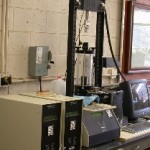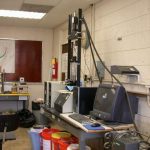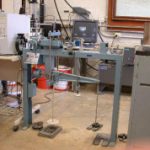The geotechnical facilities of the UPRM Civil Engineering Department consist of two laboratories: the undergraduate Geotechnical Laboratory and the Advanced Geotechnical Laboratory. The undergraduate Geotechnical Laboratory has a surface area of 1,250 square feet and consists of an enclosed air-conditioned room that includes laboratory tables installed with running water, compressed air, and propane gas lines. For the undergraduate program, this laboratory is used for lab sessions typically of up to 15 students from INCI 4139 – Introduction to Geotechnical Engineering, and for demonstrations in INCI 4049 – Foundations Engineering.
The laboratory has blackboard facilities as well as a portable screen and overhead projector used for instructional purposes prior to the students conducting their experimental work. This laboratory is suitably equipped with general soil classification and soil testing equipment to determine Atterberg limits, mechanical analyses, specific gravity, field density (rubber-balloon and sand-cone), permeability, seepage model and capillarity demonstrations, compaction (standard and modified), consolidation, and soil unconfined compression testing. Facilities are available for a variety of physical models studies such as fluid flow through soils. The overall condition to meet instructional requirements at the undergraduate level is very good.
The Advanced Geotechnical Laboratory is used for instruction in specialized soil and rock testing procedures such as direct shear testing of soils, and triaxial testing. The advanced geotechnical laboratory also houses more advanced testing equipment such as a fully automated cyclic triaxial device. This advanced lab is dedicated primarily for research at both the undergraduate and graduate levels.
The geotechnical laboratory facilities include a conventional triaxial loading frame, three (3) loading frames for unconfined compression testing and swell tests, two direct shear devices, six conventional consolidation devices, three (3) digital hydraulic consolidation frames, several mechanical sieving devices, three (3) hydrometer sets, a rock mechanics triaxial device, and an air compressor system. Both undergraduate and graduate students use this equipment.
The laboratory also has a fully automated triaxial system complete with a hydraulic loading system, a computer, a printer, and a data acquisition system that is used for static and cyclic testing. The automated triaxial system can also be used for consolidation tests and user-defined stress path testing. At the undergraduate level, this equipment is used for classroom demonstrations and undergraduate research.



